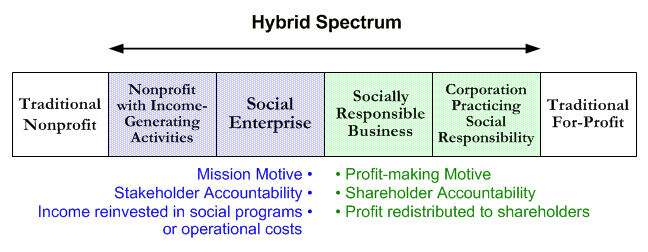Shifting stakeholder expectations of nonprofit organizations to achieve larger scale social impact while also diversifying their funding has been credited as a major factor in the appearance of the “nonprofit hybrid” part for-profit and part nonprofit.1
At this intersection of business and traditional nonprofit is where the social enterprise lies.
Spectrum of Practitioners2
| Purely Philanthropic | Hybrid | Purely commercial | |
| Motives | Appeal to goodwill | Mixed motives | Appeal to self-interest |
| Methods | Mission-driven | Balance of mission and market | Market-driven |
| Goals | Social value creation | Social and economic value creation | Economic value creation |
| Destination of Income/Profit | Directed toward mission activities of nonprofit organization (required by law or organizational policy) | Reinvested in mission activities or operational expenses, and/or retained for business growth and development (for-profits may redistribute a portion) | Distributed to shareholders and owners |
All hybrid organizations generate both social and economic value and are organized by degree of activity as it relates to: 1) motive, 2) accountability, and 3) use of income.
The Hybrid Spectrum includes four types of Hybrid Practitioners.
On the right hand side of the spectrum are for-profit entities that create social value but whose main motives are profit-making and distribution of profit to shareholders.
On the left hand side of the spectrum are nonprofits with commercial activities that generate economic value to fund social programs but whose main motive is mission accomplishment as dictated by stakeholder mandate.3

- 1Adapted from Tom Reis, Unleashing New Resources and Entrepreneurship for the Common Good: A Scan, Synthesis, and Scenario for Action. W.K. Kellogg Foundation, January 1999.
- 2Adapted from Gregory Dees, Why Social Entrepreneurship is Important to You, from Enterprising Nonprofits: A ToolKit for Social Entrepreneurs, John Wiley and Sons, 2001; and Lee Davis and Nicole Etchart, Profits for Nonprofits, NESsT, 1999.
- 3Adapted from Etchart, Nicole and Lee Davis, Profits for Nonprofits, NESsT, 1999.
